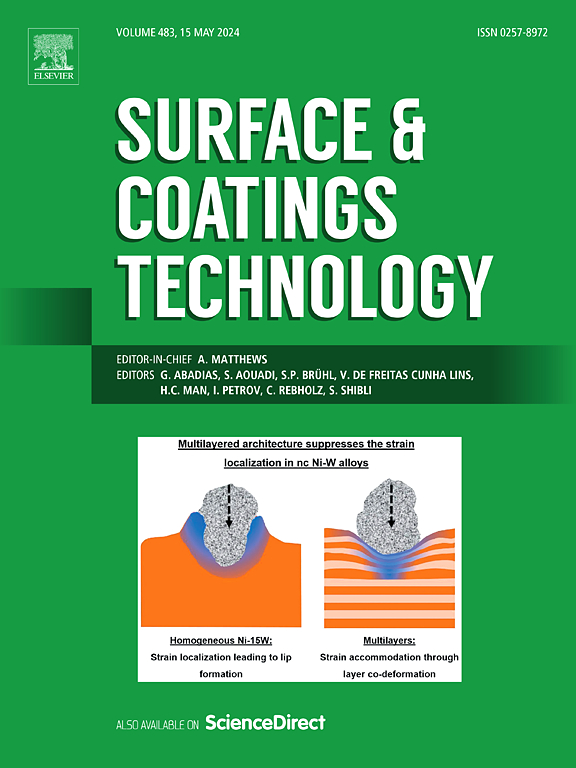Stable nanocrystalline high-entropy alloy coatings deposited by cold-spraying: Indentation deformation behavior evaluated by nanoindentation and atomic force microscopy
IF 5.3
2区 材料科学
Q1 MATERIALS SCIENCE, COATINGS & FILMS
引用次数: 0
Abstract
The leading edges of structural components such as compressors and turbine blades operating in extreme environments undergo extensive erosive and abrasive wear from impinging solid erodents like abrasive sand particles. Although traditional coatings are extensively applied on the surfaces of such components for protection and to mitigate degradation, these coatings may not always withstand the impact of solid erodents. Here, newly developed lightweight, stable nanocrystalline high-entropy alloy (NC-HEA) coatings were deposited onto an A36 steel substrate using a cold-spray additive manufacturing method, while nanoindentation technique coupled with atomic force microscopy was used to assess their nanomechanical response. Despite being 25 % lighter, NC-HEA coatings exhibit nearly four times the hardness of the steel substrate. Furthermore, the deposited HEA coatings subjected to heat treatment show notable hardness and elastic moduli enhancement. This demonstrates the simultaneous stability of the NC-HEAs against grain growth even while hardness increases. Altogether, we investigate the stability of the NC-HEA coatings and elucidate the operational strengthening mechanisms that contribute to the increased hardness values.
冷喷涂稳定纳米晶高熵合金涂层:用纳米压痕和原子力显微镜评价压痕变形行为
在极端环境中工作的结构部件(如压缩机和涡轮叶片)的前缘会受到固体侵蚀物(如磨蚀性砂粒)的广泛侵蚀和磨蚀磨损。虽然传统的涂层广泛应用于这些部件的表面以保护和减轻降解,但这些涂层可能并不总是能够承受固体侵蚀物的影响。本研究采用冷喷涂增材制造方法在A36钢基体上制备了轻质、稳定的纳米晶高熵合金(NC-HEA)涂层,并采用纳米压痕技术结合原子力显微镜对其纳米力学响应进行了研究。尽管重量轻25%,NC-HEA涂层的硬度几乎是钢基体的四倍。热处理后的HEA涂层硬度和弹性模量均有显著提高。这表明即使硬度增加,NC-HEAs对晶粒生长也具有稳定性。总之,我们研究了NC-HEA涂层的稳定性,并阐明了导致硬度值增加的操作强化机制。
本文章由计算机程序翻译,如有差异,请以英文原文为准。
求助全文
约1分钟内获得全文
求助全文
来源期刊

Surface & Coatings Technology
工程技术-材料科学:膜
CiteScore
10.00
自引率
11.10%
发文量
921
审稿时长
19 days
期刊介绍:
Surface and Coatings Technology is an international archival journal publishing scientific papers on significant developments in surface and interface engineering to modify and improve the surface properties of materials for protection in demanding contact conditions or aggressive environments, or for enhanced functional performance. Contributions range from original scientific articles concerned with fundamental and applied aspects of research or direct applications of metallic, inorganic, organic and composite coatings, to invited reviews of current technology in specific areas. Papers submitted to this journal are expected to be in line with the following aspects in processes, and properties/performance:
A. Processes: Physical and chemical vapour deposition techniques, thermal and plasma spraying, surface modification by directed energy techniques such as ion, electron and laser beams, thermo-chemical treatment, wet chemical and electrochemical processes such as plating, sol-gel coating, anodization, plasma electrolytic oxidation, etc., but excluding painting.
B. Properties/performance: friction performance, wear resistance (e.g., abrasion, erosion, fretting, etc), corrosion and oxidation resistance, thermal protection, diffusion resistance, hydrophilicity/hydrophobicity, and properties relevant to smart materials behaviour and enhanced multifunctional performance for environmental, energy and medical applications, but excluding device aspects.
 求助内容:
求助内容: 应助结果提醒方式:
应助结果提醒方式:


